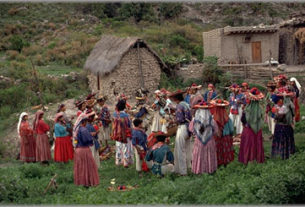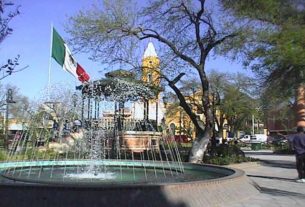Right behind Hospicio Cabañas, at the south-east corner of that building, you abruptly run into a rabbit warren of narrow streets, dilapidated adobe buildings, lots of old cars and poorly dressed people. But don’t be afraid, it’s just a working-class barrio and the people are starting their day. They greet their friends and a few will say “Buenos días” to you, too.
You and a Mexican friend are bringing two kitchen knives to the famous González knife sharpening shop. A local newspaper has just given him a writeup. He’s been so successful in his thirty years of business that he’s been able to set up five relatives in other sharpening shops around the city.
But the center of attention is an hojalatero, or auto body repairman, doing a welding job on a car door out in the street. It’s propped up so that he can weld the hinges. Sparks are flying everywhere. He wears goggles but there’s nothing to protect the eyes of passerbys from the dangerous rays. The car being repaired is parked at the curb. Across from him, also in the street, two competitors are hammering out the dents of someone else’s fender. These businessmen don’t have shops.
González isn’t at work yet – it’s barely 10 AM – and the neighboring merchant explains, ” se le pegaron las sábanas,” (the bedsheets stuck to him, or, he slept late). But you’re interested in watching the car repairs so you decide you’ll wait. Joining the activity on the corner comes a jovial one-legged man in a wheelchair and a nicely dressed friend carrying a guitar. They, too, station themselves in the street, talking with everyone, and seem to be sharing a bottle of Coke.
The welding job takes quite a while. A passerby joins you in kibitzing about the auto body work. A bus threads its way through the people and cars. A policeman makes his appearance. Surely he’ll order the guitarist and one-legged man to get off the street, or perhaps he’ll take his wrath out on the auto body workers.
He does neither. He has come to help find parking places for new body work customers. He’s surely being paid by the hojalateros. And they are surely paying the placero, the city tax collector who sees to it that all persons earning a living on the street are giving the city its due.
By now González has arrived and has started sharpening your knives. He uses large motor-driven grinding wheels. The auto body repairman is finally satisfied with his welding job on the door and he and his helper have carried it to the car and are fitting it to the body. The repairman is now crouched in an impossible and painful kneeling position squeezed in between the door and the frame of the car as he pounds on the hinges with a hammer and does other things you can’t see. This stage of the work requires the entire sidewalk so you and the other mirón (kibitzer) move back out of the way.
The guitarist has been playing and singing in a pleasant clear voice. He is evidently semi-professional. He’s not playing for money now, just for his friend. When he and his one-legged companion note your interest in their Coke bottle they laugh and give you that uniquely Mexican no-no finger waggle which means don’t look too closely at this bottle, there’s really alcohol in it.
González has finished and has returned your two kitchen knives to you, 16 pesos please. But you don’t want to leave, you want to stay to see if that car door fits!
Finally the shimming and pounding are over and the repairman and his helper are ready to make a trial fit of the door.
It closes perfectly the first time. The fairing of door and fender is excellent. All the mirones (kibitzers) voice their approval.
Now it’s time to go. You and your Mexican friend get lots of smiles because you have participated in this minor neighborhood triumph.
“That’s a typical Mexican street scene,” your Mexican friend tells you.
Yeah, you think, and in America everybody goes around so tightly wrapped up in themselves they don’t even notice their neighbors.
This article first appeared in the Guadalajara Reporter,
and appears here with their permission.



